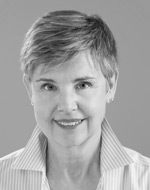Helping Women Leaders Plot Their Next Career Move
An innovative program helps seasoned women executives — including former military officers — plan what to do next.
A version of this article appeared in the Spring 2017 issue of strategy+business.
If you’re a CIA officer contemplating a new career, how do you go about assessing and describing your skills to a potential employer? Keep in mind that you are prohibited from talking about what you do, what you have learned, and who you know. Indeed, anonymity is built into the job. In the agency’s headquarters in Langley, Va., employees’ offices are marked only by a simple number, not by name or title.
This is one of many unusual problems facing the group of around 20 senior women seeking to make a career transition who gathered in an elegant Manhattan apartment for a weekend retreat early this fall. There was the recently retired CIA agent. Plus seven generals, colonels, and lieutenant colonels from various U.S. service branches — women who had run complex logistical operations, overseen multibillion-dollar budgets, and deployed to danger zones around the world. And there were 13 women from the private sector who had held high positions in finance, media, consulting, technology, and law.
All had just retired or were preparing to do so. And because they were eager to put their lifetime of well-honed skills to work in a new career, they had come together for a program called Mission: Getting to Next (MGTN). Although all the attendees were on a quest for self-reinvention, the women from the armed services faced challenges that went to core questions of identity and contribution. Who were they when they were no longer General X? How might they operate in a fluid world that lacks the clear structures the military (or an intelligence agency) provides? And how were they supposed to engage in open back-and-forth when their many decades of training emphasized keeping personal views to themselves, following orders, and minimizing risk?
Brigadier General Marianne Watson knew firsthand what the women gathered were facing. Having retired in her early 50s from her position of director of manpower and personnel for the Army and Air National Guard, in which she set policy for 450,000 officers and enlisted soldiers, she had struggled to imagine what might come next. Her husband’s death seven months before retirement added to her feeling of being at sea. “I didn’t see a path forward and I had no idea of what kind of opportunities were out there or what I could do,” she says. “And I had no network of support that could help me because there are so very few women at my level in the military.”
Yes, the military offers some training in tactical skills to retiring officers — resume writing classes, even advice on dressing for success. But the reflective work of self-examination and connection required greater depth. “Having the opportunity to sit with women who were at my level from the private sector as well as different branches of the service gave me an understanding of all the possibilities out there, beyond just defense-related industries,” says Watson, who was looking for something completely different. After considering starting a hydroponic farm and using the resources provided by the program to research it, she concluded that her situation required a less dramatic transition. So she went to work as director of outreach for Center for America, a n onprofit that educates small businesses about military hires. She also joined MGTN as co-CEO.
Watson noted that participating in the program helped her see “that it was OK to be confused and vulnerable when I was in the process of trying to figure things out.” A lieutenant colonel at the fall gathering echoed her observation: “It was unprecedented for me to have the chance to dig deep and know I wasn’t alone.” She noted that it gave her a rare opportunity to connect with women from the other service branches.
Reinvention retreats have become popular as more people pursue spiral careers — careers that unfold in stages throughout the course of one’s life rather than proceeding predictably along a straight line that ends abruptly at retirement. Spirals have been reshaping how people approach work and career since the mid-1980s, when technological innovation began to upend the lifetime employment expectations of the postwar era.
Women have often led the trend. After all, they are more likely to have entered the workplace relatively late and to have taken periods of time away from full-time work when their children are young. Because they also live longer and tend to have less financial security than men, women are particularly likely to pursue second or third careers upon reaching what used to be considered retirement age.
Carole Hyatt, a pioneering and hyperconnected New Yorker whose career as an executive and entrepreneur began in the early 1960s, started the program that became MGTN in the mid-1980s. She wanted to help women who had had successful careers, but had no wish to retire, think through the next twist in their spiral. Having begun her career at CBS, founded and sold the market research firm Hyatt Esserman, and then founded the Leadership Forum, a networking organization that connects women all over the world, Hyatt knew the challenges of continual self-reinvention that an ever-evolving path requires. And as the author of the pioneering bestseller The Woman’s Selling Game (Warner, 1979) as well as the groundbreaking When Smart People Fail (Penguin, 1987), she was skilled at sharing what she had learned in a way that inspired and encouraged others.
So when Hyatt began noticing successful women from their late 40s through their 60s contemplating second (or third, or fourth, or fifth) acts, she saw a business opportunity. She began offering workshops designed to help women identify what they wanted to do next — and build both the plan and the network required to act on their goals. She called the program Getting to Next and delivered workshops multiple times a year in her Manhattan apartment or her home in Stockbridge, Massachusetts. Getting to Next drew participants mostly from the U.S., but also from around the world. Prime ministers, senior academics, and high government officials as well as women from the private sector flocked to the program for nearly 30 years, increasing the power and scope of the shared network.
Then, at a professional lunch in 2012, Hyatt sat next to a woman in her early 50s who mentioned she was looking for a new job. Hyatt asked what the woman had been doing and the woman responded simply, “I was a general.” “A general of what?” “In the U.S. Army.” Hyatt was astonished. “I barely knew there were women generals, and I’d certainly never met one — I’d been completely disconnected from the military throughout my career. So I was intrigued and asked a lot of questions. It turned out this woman had headed up a huge team, had numerous degrees, and had worked all over the world.”
Hyatt assumed employers must be beating a path to the general’s door, but that was not at all the case. The general had virtually no network outside the military and little idea of how her skills might be applied in a different setting. Her interviews had led nowhere, though several companies had invited her to speak at their conferences, without offering payment. Having left behind the solid identity and firm sense of purpose and belonging that the military provided, she wasn’t sure where she fit in.
The general had few connections outside the military and little idea of how her skills might be applied in a different setting.
Hyatt couldn’t forget this general. She was disturbed that a woman with her skills and experience could be struggling to find work. She was distressed that decades of service to the country could be so undervalued. And she was intrigued by the new and wholly overlooked market niche the general represented. Why shouldn’t senior military women have access to her program?
She began cold-calling military bases around the country, trying to learn the names of female officers. Hyatt made little progress until she attended a conference sponsored by Women in Defense in Washington, D.C. “A speaker there mentioned she was about to retire, so I ran up afterward to give her my card and invite her to my next program free of charge,” she recalls. “She knew other senior women in the service, so we were able to build the program based on that.”
The experience of having a military officer present was so powerful that Hyatt reinvented her entire program. Committing to the goal of having nearly equal representation of military and civilian women at every event, she renamed it Mission: Getting to Next and redesigned the workshop so that soon-to-be veterans and civilian senior women could make maximum use of one another’s skills, insights, and especially networks.
Hyatt reconfigured her business as a nonprofit so sponsors could be enlisted for support and so they could network for recruitment. She made it more robust by adding mentors and a coach from One to One Women Coaching Women, as well as a three-month mentoring program for all participants. Military participants have access to a mentor from the private sector for a year.
Hyatt's own story exemplifies the power and inspiration of spiral careers. At the age of 82, she speaks continually of her program’s expansion, flies around the world to scout prospects in locations as remote as Kazakhstan, and continues to ask the question that has always guided her: So, what can I do next?
MGTN is now expanding to serve more midlevel women looking to make a transition. “There is an out flux of military women retiring and we need to be able to help them, and even expand our program to serve military spouses,” says Joan Firestone, MGTN’s executive director. “Creating military/civilian networks is so beneficial. Military women have been isolated, and now they can share a commonality of experience. And civilians get exposure to the military in a way I don’t see elsewhere.”
Reprint No. 17105




